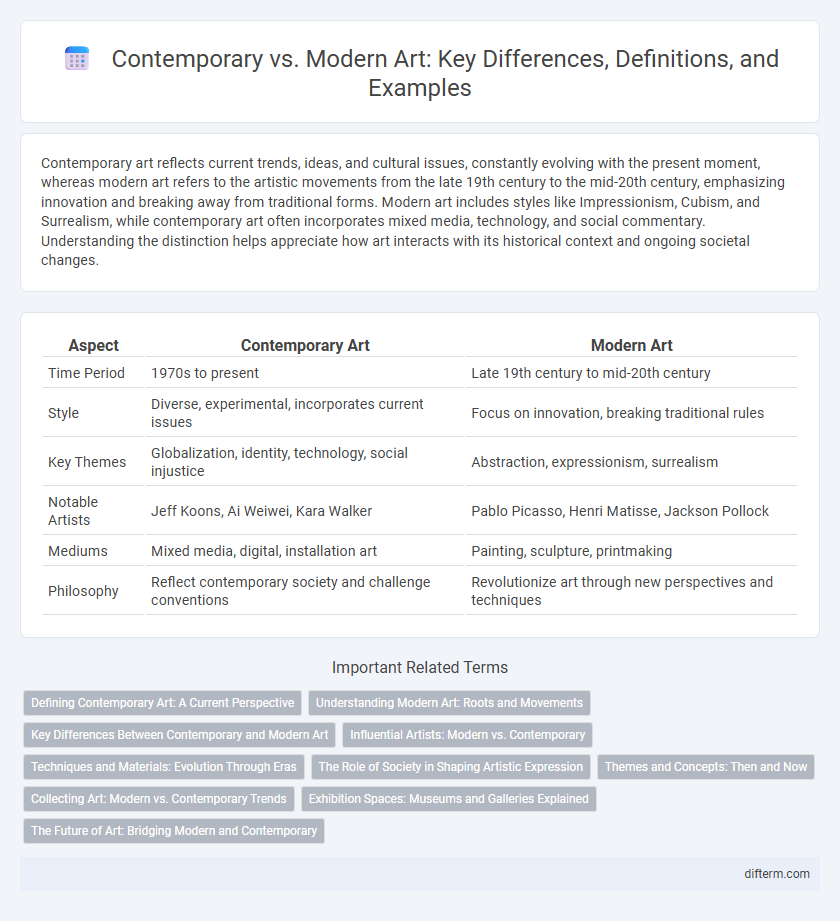Contemporary art reflects current trends, ideas, and cultural issues, constantly evolving with the present moment, whereas modern art refers to the artistic movements from the late 19th century to the mid-20th century, emphasizing innovation and breaking away from traditional forms. Modern art includes styles like Impressionism, Cubism, and Surrealism, while contemporary art often incorporates mixed media, technology, and social commentary. Understanding the distinction helps appreciate how art interacts with its historical context and ongoing societal changes.
Table of Comparison
| Aspect | Contemporary Art | Modern Art |
|---|---|---|
| Time Period | 1970s to present | Late 19th century to mid-20th century |
| Style | Diverse, experimental, incorporates current issues | Focus on innovation, breaking traditional rules |
| Key Themes | Globalization, identity, technology, social injustice | Abstraction, expressionism, surrealism |
| Notable Artists | Jeff Koons, Ai Weiwei, Kara Walker | Pablo Picasso, Henri Matisse, Jackson Pollock |
| Mediums | Mixed media, digital, installation art | Painting, sculpture, printmaking |
| Philosophy | Reflect contemporary society and challenge conventions | Revolutionize art through new perspectives and techniques |
Defining Contemporary Art: A Current Perspective
Contemporary art encompasses artworks created from the late 20th century to the present, reflecting current societal issues, technological advancements, and global cultures. Unlike modern art, which primarily spans from the late 19th century to the mid-20th century and emphasizes innovation and abstraction, contemporary art integrates diverse media, interdisciplinary approaches, and conceptual frameworks. Prominent contemporary artists such as Ai Weiwei, Kara Walker, and Banksy challenge traditional boundaries, highlighting the dynamic and evolving nature of art in today's world.
Understanding Modern Art: Roots and Movements
Modern art originated in the late 19th to mid-20th century, emphasizing innovation and a break from traditional forms through movements like Impressionism, Cubism, and Surrealism. It reflects artists' responses to industrialization, urbanization, and new philosophies, seeking to capture subjective experiences and abstract concepts. Understanding modern art involves exploring its varied movements that challenged classical aesthetics and paved the way for contemporary experimentation.
Key Differences Between Contemporary and Modern Art
Modern art primarily refers to works created from the late 19th century through the mid-20th century, emphasizing innovation, abstraction, and a break from traditional forms. Contemporary art encompasses art produced from the late 20th century to the present, reflecting current issues, diverse mediums, and global perspectives. Key differences include the historical timeframe, stylistic approaches, and the thematic focus on present-day culture in contemporary art versus the historical progression and experimentation in modern art.
Influential Artists: Modern vs. Contemporary
Modern art features influential artists like Pablo Picasso and Henri Matisse, who pioneered abstract and cubist styles transforming early 20th-century visual culture. Contemporary art highlights figures such as Ai Weiwei and Yayoi Kusama, known for innovative approaches blending technology, social commentary, and immersive installations. These artists shape distinct artistic movements reflecting evolving societal and cultural landscapes across different eras.
Techniques and Materials: Evolution Through Eras
Contemporary art embraces a wide range of techniques and materials, including digital media, installation, and recycled objects, reflecting current cultural and technological advancements. Modern art primarily focused on traditional media like oil paint, sculpture, and printmaking, emphasizing innovative approaches such as abstraction and surrealism. The evolution from modern to contemporary art highlights a shift from medium-specific experimentation to interdisciplinary and conceptual practices that challenge conventional boundaries.
The Role of Society in Shaping Artistic Expression
Contemporary art reflects current societal issues and diverse cultural identities, emphasizing inclusivity and global interconnectedness in its themes. Modern art, emerging in the late 19th and early 20th centuries, challenged traditional aesthetics and represented rapid industrialization and urbanization influences. Both movements illustrate how societal changes drive artistic innovation, with contemporary art responding to digital technology and social activism, while modern art responded to industrial progress and ideological shifts.
Themes and Concepts: Then and Now
Contemporary art explores diverse themes such as identity, technology, and social justice, reflecting current cultural and political concerns. Modern art focused on breaking traditional norms, emphasizing abstraction and experimentation with form and color during the late 19th to mid-20th centuries. Contemporary artists often integrate multimedia and global perspectives, while modern art prioritized innovation and formalism within a more limited historical context.
Collecting Art: Modern vs. Contemporary Trends
Collecting modern art involves acquiring works created from the late 19th century to the mid-20th century, emphasizing movements like Cubism, Surrealism, and Abstract Expressionism. Contemporary art collecting focuses on pieces produced from the 1970s onward, often featuring experimental media, digital art, and socially engaged themes. Market trends reveal rising demand for contemporary artists, driven by global auctions, online platforms, and a younger collector base seeking innovative and culturally relevant works.
Exhibition Spaces: Museums and Galleries Explained
Contemporary art exhibitions are often showcased in innovative galleries that emphasize interactive and immersive experiences, while modern art is typically displayed in established museums dedicated to 20th-century movements. Museums like the Museum of Modern Art (MoMA) focus on historically significant modern artworks, whereas spaces such as the Tate Modern and the Garage Museum emphasize cutting-edge contemporary art practices. The design and curation of these venues reflect their distinct missions to engage audiences with either historic modernism or evolving contemporary trends.
The Future of Art: Bridging Modern and Contemporary
Exploring the future of art requires bridging modern and contemporary movements, highlighting how modern art's foundation of innovation and abstraction paves the way for contemporary art's diverse, multimedia expressions. The integration of digital technology and global perspectives in contemporary art expands upon modernism's legacy, fostering new forms of interactive and immersive experiences. This synergy propels artistic evolution, emphasizing creativity that reflects societal changes and technological advancements.
Contemporary vs modern Infographic

 difterm.com
difterm.com